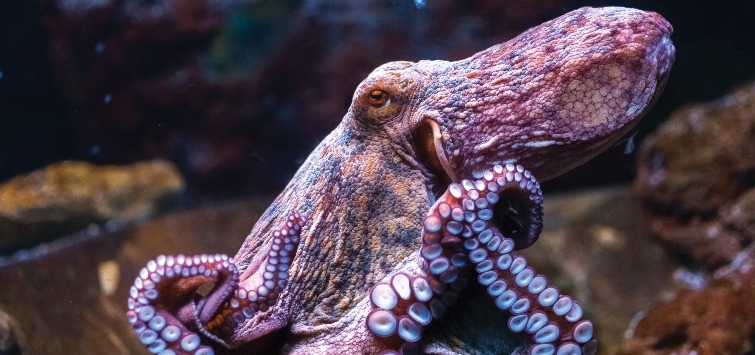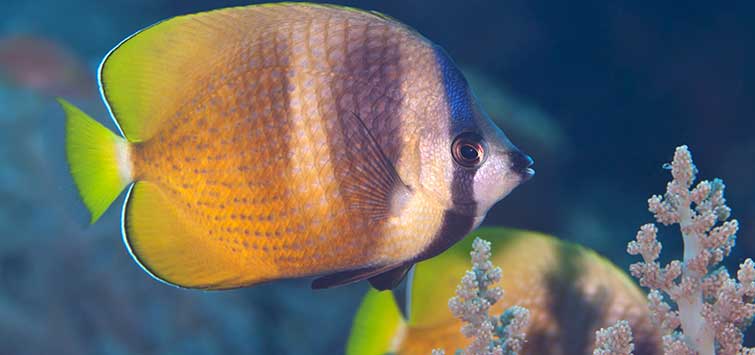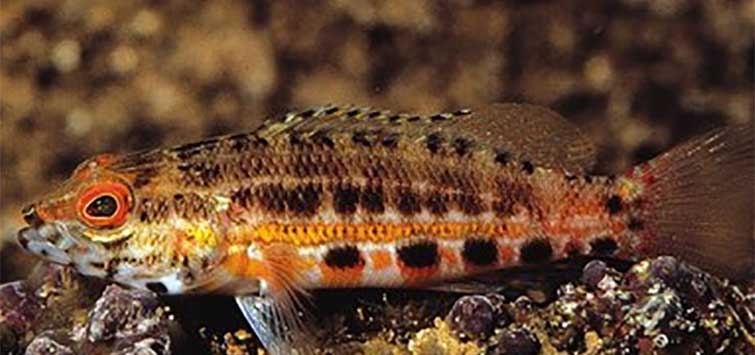Choosing and Keeping a Pet Octopus
Sooner or later, many aquarists become interested in keeping a pet octopus. After all, octopuses are curious and intelligent, and they have many intriguing abilities that set them apart from other tank inhabitants. They can rapidly change colors and textures, make eye contact and interact with you, use their multiple arms to play with toys, and even, on occasion, watch television with you.
It’s all very rewarding, but the truth is that, even with the proper tank setup and the right food, keeping a pet octopus isn’t for everyone.
If you already have an empty, mature marine tank that is ready for an octopus or are setting up a saltwater tank for the first time and want to add one, you will need a fully cycled tank with live rock to provide places for your new octopus to hide. Beginners should allow some extra time to get everything ready for their new venture.
There is much to consider before buying an octopus. Purchasing the octopus will not be your main expense; that will be the tank, equipment, and food costs. The last category can get quite expensive, because octopuses prefer a diet of shrimp and crabs. And while most octopuses can be offered thawed frozen raw shrimp, your octopus will need to be given some live food as well.
Tank Setup
As for housing, a reef tank that is large enough for the species you plan to keep is a must, as is a central pump and a Berlin-style or refugium-based filtration system with a protein skimmer. A fine actinic sand bed of an inch or two (2.5 to 5 cm) is preferred to help keep the pH high enough.Avoid bright lights, so no metal halides, and tone down your LEDs. If you want to view your octopus at night, use a red light, never blue.
The pet octopus tank is essentially a species tank, because only one octopus, and therefore one species, is the sole major inhabitant. One possible exception is the dwarf octopus (Octopus mercatoris). Two of those small octopuses may inhabit a 30-gallon (113-liter) tank. Plan to also have a few snails and small crabs as members of the cleanup crew.
Absolutely no fish should be kept with the octopus. Fish and even shrimp can harass a young octopus, and eventually the octopus will grow large enough to prey on them. Also be sure to remove any large invertebrates to another tank to prevent a catastrophe. Octopuses have been trapped and killed by sea stars, for example.
You can keep certain non-stinging corals with an octopus, but remember that octopuses often rearrange their rocks and run over corals, and they have been known to snap off a gorgonian and place it by their den.
Aquarium Care
Most octopus keepers feed daily using a feeding stick, usually offering a small piece of defrosted frozen raw shrimp or occasionally live food items, such as small shrimp, crabs, or even a crawfish, as a rare treat. Because you don’t want your octopus to suffer any injuries, it’s best to remove any large claws before offering live crabs or crawfish.The octopus is a messy eater, so you’ll need a protein skimmer to help keep the water clean, and you’ll need to regularly remove uneaten food, crab carapaces, and other messy items from the tank. Plan to carry out a 20-percent water change every two weeks and test your water frequently. The parameters you will be concerned with are aquarium water salinity, pH, ammonia, nitrates, and nitrites. Also, make sure that any places your octopus could escape the tank are blocked.
There are many different octopus species, and you will find octopuses with different behaviors and personalities even within a single species. Some are outgoing and interact a lot, while others are shy. They are all curious and intelligent and will make frequent eye contact with you.
Most young octopuses are timid at first and hide either in their dens or camouflaged on live rock, where you will have difficulty spotting them. Eventually, you’ll develop “octopus eyes” by spending time sitting by the tank and watching carefully until you can see your octopus. If you can’t find your octopus at first, don’t tear up the tank looking for it! As they grow more confident and less afraid, octopuses will show themselves more often and become more interested in you as well.
You might be concerned that your octopus will bite you; after all, they have those sharp beaks. This happens very rarely, though, and with most species we commonly keep, it usually isn’t a very significant bite if it does occur.
Another concern is inking, which all octopuses can do as a defensive measure, most likely if they are startled. You may never experience this, but if your octopus does ink, your tank’s filtration and a water change should remove most of it.
Enrichment and Play
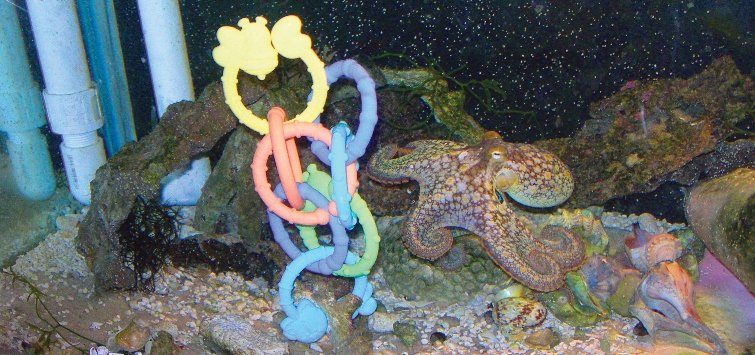
Octopuses sometimes play with toys, but their preferences as to which toys are quite individual. One small O. bimaculoides liked to float around on a large, partially submerged Lego® block. Another played with baby toys, and yet another preferred small shells. They can surprise you, though—some may show no interest whatsoever in toys, while others will enjoy opening boxes or unscrewing jars, especially if there’s food inside.
One of the main sources of their enrichment, however, can be you. Octopuses do well and grow friendlier with a lot of attention. The feeding stick can become a toy for playing “pull the stick,” which is very similar to playing tug of war with your dog.
Your octopus most likely will be curious about you and want to touch you with the tip of its arm. Use one fingertip to cautiously make contact. The first time, it might scare both of you!
Lifespan and Reproduction
One of the downsides of keeping a pet octopus is their short lifespan, especially since octopus keepers can grow very fond of their octopuses. A dwarf octopus has a lifespan of approximately six months, and a small-to-medium-sized octopus, such as O. briareus or Abdopus aculeatus, may live longer, about one year. A larger octopus like O. vulgaris may live up to 2 years, and the giant Pacific octopus and other octopuses living in very cold waters have the longest lifespans.Octopuses are solitary animals for the most part. They tend to reproduce at the end of their lives. The male transfers his sperm packet to the female, who can carry the sperm and use it when she wants. This results in some aquarists acquiring an octopus that lays eggs a few weeks later. She will tend the eggs, keeping them clean and the water around them moving, but she most likely won’t eat during this entire period. She will pass away soon after her eggs hatch.
Finding an Octopus
Over time, the availability of any given octopus species changes. Suppliers come and go, and hurricanes and weather conditions affect the availability of certain species, so it’s best to remain flexible and choose the best among the species that are actually available when you’re looking.A few people with the resources to do so capture their own octopuses, but most aquarists purchase their new pets. Most octopuses offered for sale are wild caught, because octopuses are difficult to breed and demand for them as pets is not great.
Octopuses may be available at your local aquarium store, or the store can order one. In the last few years, more people have successfully acquired their octopuses in this way. However, these stores are often limited in the species they can supply. Also, the suppliers may not really know their species. More than likely, you will receive a “Pacific brown octopus” or an octopus described in a similarly vague way, but it may still be a good octopus for you.
Those offered by online fish stores may not be what they seem. For some sites, the species listed or even the photo shown may be incorrect. Wherever you buy, be sure to talk with the person in charge and find out where the octopuses come from and as much other information as you can before ordering. People do buy their octopuses from these sources and often end up pleased with their new friends.
Individuals or small stores along the coast with access to octopuses are a third source. Some are owned by divers who do their own collecting. These people tend to know their species well. You may find O. briareus offered by one of these stores.
Check octopus-keeping websites, such as TONMO, which has an Octopus Availability thread and a List of Our Octopuses, for tips. You’ll be able to see where people have recently found octopuses and investigate their sources.
Available Pet Octopus Species
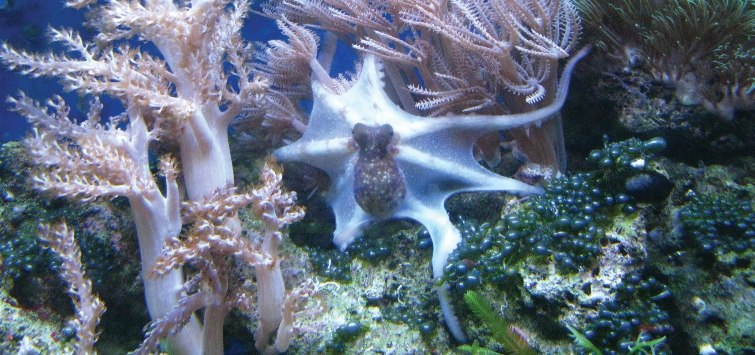
Below are some of the most commonly kept pet octopus species at present. In addition, many other species find their way into our tanks from time to time.
O. briareus is a long-legged octopus commonly found off the Atlantic coast of Florida and the Caribbean. It is a beautiful, graceful octopus that captures its prey by covering a coral with its deep webbing and flushing out the small prey it finds there. It is diurnal (active in the day) and a good tank inhabitant. O. briareus is one of the most popularly kept octopuses.
A. aculeatus is a long-legged octopus from the Indo-Pacific region that is relatively easy to find for sale, so many people are currently keeping this species. It lives in intertidal areas and is excellent at camouflage. A. aculeatus is small, diurnal, and friendly, but you may have difficulty finding a young one.
O. mercatoris and related species, such as O. joubini, are dwarf octopuses found off the Florida coast and the Caribbean. These are the smallest octopuses usually offered for sale. You might also acquire one by accident, as they are common hitchhikers on live rock. Nocturnal by nature, one or two can live in a 30-gallon (113-liter) tank.
The dwarf O. bocki is sometimes confused with O. mercatoris, but O. mercatoris is far more common. O. bocki can be recognized by the two black spots on the underside of its body.
O. bimaculoides, my personal favorite, is now mostly available by collecting it yourself along the southern California coast. (You need a fishing license to do so.) Also known as the bimac or California two-spot octopus, O. bimaculoides can be identified by their distinctive eyespots. They are small to medium in size, friendly, diurnal, and very adaptable. Bimacs prefer at least a 75-gallon (284-liter) tank and require cooler temperatures, at least below 70°F (21°C). If you live in southern California, you might try finding O. bimaculoides by searching tide pools. If you’re lucky, you might find one for sale.
O. vulgaris is easier to find now than it was in the past, so more people are keeping this pet octopus species. The O. vulgaris that lives off our southern coasts and the Caribbean is known as the Caribbean common octopus and is smaller than the O. vulgaris found in the Mediterranean area. They can be very interactive, intelligent, and sometimes aggressive, and they usually have a lifespan of up to two years. Being a medium-to-large-size octopus, they will need more food and a larger tank, from about 150 to 200 gallons (570 to 760 liters), so keep this in mind if you are considering one.
A Brief yet Rewarding Relationship
Octopuses are interesting, intelligent pets. Even the shyer, less interactive ones, like the dwarf octopuses, are still intriguing to watch. And if your octopus is more outgoing and interactive, as many are, you’ll have a lot of fun with it. Some octopuses even have a mischievous side, and all of them will in some way entertain you. The color and texture changes alone are remarkable to see. However, the more time you can spend with your octopus, the more interesting a relationship the two of you will develop.Their tragically short lifespan is definitely a downside, so be sure to consider that aspect before you begin. But keeping an octopus is a rewarding and challenging experience, and one you will learn a lot from on top of all the fun.
Nancy King is the coauthor of Cephalopods: Octopuses and Cuttlefish for the Home Aquarium (2009, TFH Publications, Inc.) and a moderator at The Octopus News Magazine Online.
See the full article on TFH Digital
https://www.tfhdigital.com/tfh/jul_aug_2018/MobilePagedReplica.action?pm=2&folio=76#pg79

.png?h=595&iar=0&w=2781&hash=5FD5E69473BCC22199FBFA2FB71B6033)
